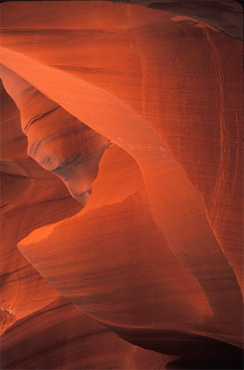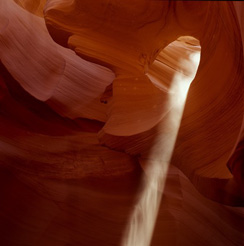Nature up close: Antelope Canyon
By contributing "Sunday Morning" nature videographer Judy Lehmberg:
Antelope Canyon, near Page, Arizona, is probably the most famous slot canyon in the world. Slot canyons form when rock is eroded periodically by water, usually in relatively dry areas such as deserts. Antelope Canyon formed when periodic rains carved into the sandstone.
Antelope Canyon is deceptive. From above it appears as a narrow opening in the Navajo sandstone formation that extends for miles. But from inside the canyon, the walls are several yards or more apart, and in places the canyon is up to one hundred feet deep.
Navajo sandstone was formed by aeolian deposition from around 191-174 million years ago. Since that time, iron oxides have been deposited on some of the sand grains in varying amounts giving the slot canyon layer after layer of every shade of red.
From the outside it doesn't look like much, but once you're inside it's a different story.
Because of its beauty and accessibility, Antelope Canyon is the most-photographed slot canyon in the world. Photographers obviously have to have a subject to photograph, but once they do the difference between a good photograph and an absolutely stunning one is the light.
It is all about the light.
The best time to photograph Antelope Canyon is when the sun is directly overhead in the middle of the day, so the best time of year is as close to the summer solstice as possible.
My husband and I are both photographers; he does stills, and I do movies. He cares about rocks and landscapes; I don't. So when we went to Antelope Canyon the first time I was along for the ride, but didn't care about the photography.
As I said, it is all about the light. We got there at mid-day when the light was streaming down.
Some of the best photographs of Antelope Canyon have shafts of light that almost look like you could reach out and touch them, like in the photo at left. I had no idea how to create that look, but my husband did, and he knew who he could con into making it happen. He told me to stand behind a bend in the canyon right next to where he was pointing his camera and to throw sand up in the air. To get those shafts of light, someone has to throw a bunch of sand up in the air, wait for the larger, heavier particles to land and then take the photo while the very small, dust-like particles are still suspended in the air. That's what gives the shafts of light that feeling there is something other than light there, because there is -- really fine particles of sand.
Notice I said the sand has to be thrown straight up. There also needs to be a lot of sand. So I stood behind a corner throwing sand. The more I threw, the more it landed on me. It was landing all over me, in my hair, down my shirt, everywhere.
I was getting pretty tired of throwing sand all over myself (and I'm not a very good shot when I throw anything), but then two other photographers appeared and started taking photos with my husband. They really liked my "technique." I guess I was flattered so I kept it up. When they finally had enough I came out from my hiding place. When I saw the looks on their faces I realized I must have looked something like a red dust cloud with legs.
My husband has been back to Antelope Canyon several times, but I have always found something better to do than go back to that dirt bath. When it comes to that canyon I can admire his photos much better after he takes them.
If you would like to photograph Antelope Canyon, there are tours that originate in Page, Arizona, or you can drive to the canyon yourself. It is on Navajo Nation land, and there is a charge to take you from a parking area to the canyon.
Before you go be sure to check the weather forecast. Pay particular attention to the weather several miles above the canyon. Flash floods don't happen often in the desert, but they do happen, and a number of people have died when water came rushing down the canyon after a hard rain.
Judy Lehmberg is a former college biology teacher who now shoots nature videos.
For more info:
- Judy Lehmberg (Official site)
- Judy Lehmberg's YouTube Channel
To watch extended "Sunday Morning" Nature videos click here!

